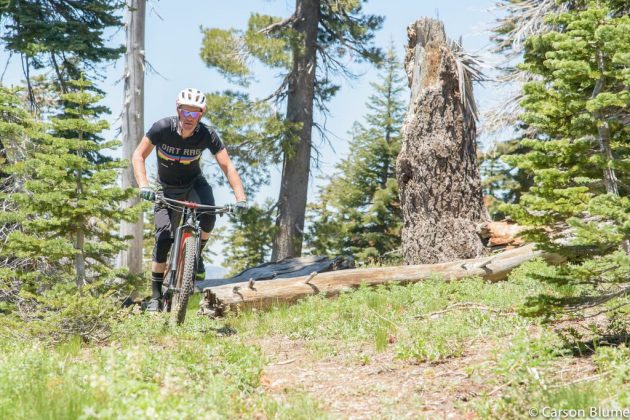First Impression: 2016 Specialized S-Works Camber FSR Carbon
Originally posted on July 6, 2015 at 12:37 pmAction photos by Carson Blume

Destination: Trail. That was the buzzword surrounding the much anticipated launch of the all-new Specialized Camber. To showcase just how capable and versatile this bike is Specialized choose the Downieville and Lakes Basin area in Northern California as launch headquarters, based out of the Graeagle Lodge which proved to be a celestial mountain bike destination with amazing trails accessible right from your cabin door. While this is dirt heaven it’s not without its devilish side—the trails vary from high-speed flow with bermed switchbacks to gnarly rock gardens and slabs that require full attention at speed. And accessing all this bliss requires a healthy dose of long distance climbing over the same style of terrain at high altitude. In a nutshell, this was mountain biking at its finest.

The Specialized Camber was already a favorite around here, but we’ve been hoping for an update to take the geometry to a more modern place and our hope was not misplaced for 2016. Besides a shorter rear-end and slacker geometry, Specialized also developed a position sensitive micro Brain rear shock and RockShox RS-1 fork specifically for this model, both of which include an all-new spike valve.
The big news about the Camber Brain is that unlike the shock on the cross-country specific Epic which has its inertia valve engaged at all times this one remains inactive until 25-percent of sag is reached to keep it tender as well as responsive to smaller bumps and unloading. This “trail focus” as Specialized calls it gives the shock free float off the top and then once the 25-percent sag point is hit the inertia valve kicks in.

“For the first time Camber gets an all new position sensitive micro Brain. We believe in active, independent suspension and this is a direct connection, everything meets at the same spot and very similar to what’s on the Epic,” Sam Benedict, Specialized marketing manger quoted. “We’ve tried Brain on trail bikes like the Stumpjumper but never got the right active trail feel we needed but with this we found it.”


In describing the comparisons he continued, “All the compression and tuning is very different compared the Epic Brain shock. Sit on it and you don’t feel any Brain engagement and that’s because of the design. It doesn’t engage until the sag point is met, the first 25-percent of travel there is no inertia valve. Where we do want the Brain is climbing, when you start climbing you’ll sag in and get a solid platform; firm pedaling but active and independent when you hit a bump. This is the first time we’ve made a position sensitive Brain specific to trail bikes.”
The front triangle is shared with the new Stumpjumper, it’s called a “trail chassis” with the front triangle being designed for both bikes, which were being developed together so the Camber isn’t just a downsized Stumpjumper. This also means the carbon bikes get the nifty SWAT door for on-bike storage of tubes and tools in the downtube. The concentric FSR link, shock yoke, mini air sleeve, Auto Sag, and of course the inertia valve mounted to the rear of the frame near the axle at a 16 degree angle are similar to what’s found on the Epic.

There won’t be two geometries like the current model but rather just one based on EVO numbers but with a few substantial tweaks. Additionally, with the bike being offered in either 27.5 or 29-inch wheel sizes, and each one has dedicated geometry.

My test time at Graeagle and also at home in Pennsylvania was on the S-Works 120 mm 29er and I can say it is simply amazing, it feels like an Epic on steroids. “A trail bike first and foremost, a confident trail bike based on speed,” is what Benedict calls it and I’m in complete agreement.
Lofting the front wheel is effortless and the bike hugs the trail as if it’s on rails. Once settled into the sag, the Camber climbs very efficiently without the skipping that sometimes happens with the Epic’s more aggressive valving—this keeps the Camber gripping on the steepest and roughest of climbs. It’s also a speedy descender with a distinct trail bike feel, not an overdone freeride bike. The position sensitive Brain is a wonderful thing, it stays active off the very top when you need it but once settled the Camber climbs very quickly, of course that’s helped by a 27.7-pound weight (size medium w/o pedals) with Purgatory Control 2.3 inch tires.
To me, this is a true do-it-all bike if you like your fast, technical descending complimented by punchy climbing that varies from smooth to crawling up the scree—helped by a 28-tooth front ring on the SRAM XX1 group. The addition of the custom spike valve makes a world of difference with the RockShox RS-1, it fully opens on abrupt hits and once I dialed in the air pressure I was able to get full travel on every ride without complaint.
Another component of note is the new 125 mm travel Command Post IRcc dropper. It has 10 positions and one of the best engagement levers I’ve used.

There will be a wide selection of Camber models to choose from, including what Specialized calls the Module which includes the frame, shock, RockShox RS-1 fork, Roval Traverse SL carbon wheels and Command Post IRcc dropper. All you need to add is the drivetrain and cockpit. For the kids you’ll find the GROM, which comes with 24-inch wheels, enough spacing for 26ers as they grow and 110/130 mm of travel.
- S-Works Camber FSR Carbon 29/27.5 – $9,800
- S-Works Camber FSR Carbon 29/27.5 Module – $7,300
- Camber FSR Expert Carbon 29/27.5 – $6,200
- Camber FSR Comp Carbon 29/27.5 – $3,800
- Camber FSR Comp 29/27.5 – $2,500
- Camber FSR 29/27.5 – $1,850
- Camber FSR GROM – $2,200